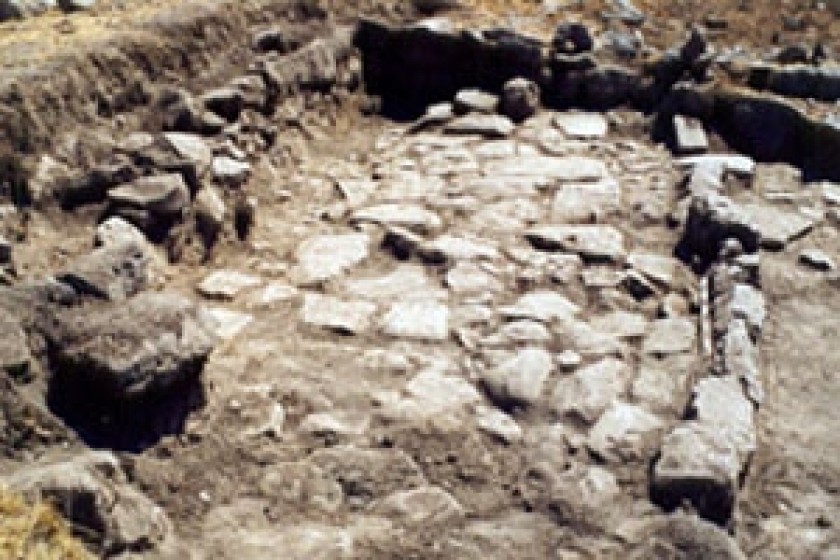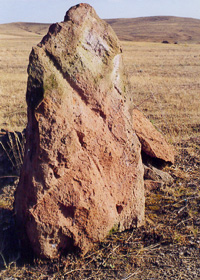
Armenian Pagan Deities Are Reappearing
Nineteen years ago historian Hayk Hakobyan had no idea that he was standing above an entire complex of pagan temples. In 1987 he and a group of archaeologists arrived in the village of Hoghmik in the Amasia region to study the area before the construction of the Kaps reservoir began. “The Hoghmik Complex was discovered by accident. I remember it was a very cold and rainy day. We began working and some three hours later a 13-meter-long and half-a-meter-wide platform with bones of sacrificial animals was revealed. We decided to stay,” Hakobyan recalled.
The summer residence of the Armenian gods
Near the village of Hoghmik, just four kilometers from Amasia, the archeologists discovered a complex of pagan temples. They carried out excavations between 1987 and 1993, but for very short periods of time. Because of financial problems, the group wasn't able continue its work until this year. Before that, they had all kept silent about the existence of the complex.
Today only one-twentieth of the complex has been studied; Hakobyan has trouble saying just how many generations it will take to uncover the complex completely. The work is expensive—it costs at least one million drams (about $2,500) to carry out excavations just one month per year. But this year, one month of work yielded the discovery of a temple of the goddess Anahit. Both in the times of Urartu and in pagan times, temples to all the major gods were built in complexes. According to Hayk Hakobyan, the Hoghmik site includes temples of all the principal pagan gods: Aramazd, Vahagn, Anahit, Astghik, Mihr, Barsham, and Nane.
The complex was built before Christ, during the reign of Artashes II. “I'm sure it's a whole district of pagan temples. The district stretches out one hundred meters on either side of an 80-meter-long avenue. The temples were built along both sides of the avenue. The pivot of the district consists of the halls of the three principal pagan gods, Aramazd, Anahit and Mihr,” Hakobyan said. A small earthen disc was found in one of the halls with the Greek inscription: “Four horses are being sacrificed to Mihr.” Horse skulls or entire skeletons have been discovered in nearly every room.
Children too were sacrificed in Hoghmik
 |
Today fifty structures have been uncovered within the pagan district that illustrate just what a pagan temple really was. Numerous pieces of earthenware crockery and other objects were found during excavations and are now in the Shirak Archeological Museum. Clay objects, iron chandeliers, and a Bronze statuette of Mihr were also discovered. And in one of the rooms, skeletons of a priest and two children were found. “One of the buried priests is 190 centimeters tall. He was buried lying on his side. There are skeletons of children next to him facing each other. These children were probably temple slaves who were sacrificed,” Hakobyan explained.
Hakobyan said that this is the first time that ancient sacrificial altars are being studied in Armenia. “There were two types of altars at that time. The victims were killed on one of them – an axe-shaped object was also found, and the offering was made on the other. There are small pools near the entrance to the building for the priests to wash their hands before the rite. The ritual also required that the priests shave their heads. An iron razor was also found in Hoghmik.”
There are round holes next to the altars for tying the animals before the sacrifice. “In the pagan era, people filled vessels with a mixture of animal blood, milk, and seeds, and threw them into the river. In this way they fed their gods to gain their favor. The pagan gods were very jealous and demanding,” the historian noted. He believes that the Hoghmik temples served six villages located along a six-kilometer stretch of the river.
The complex is made up of three layers with obvious signs of reconstruction. It functioned until the 3 rd or 4 th century AD. After the adoption of Christianity, the temples were not destroyed but gradually sealed shut. The excavations yielded an understanding of how. “The process is very interesting. After making a sacrifice, people locked the door and moved to another room. And some time later all the rooms of the complex had been sealed shut. The scene reminds you of Ancient Rome. Soon after Christianity replaced paganism during the reign of Constantine the Great, priests closed the temples dedicated to Mithra weeping and wailing in the hope that one day Mithra would return. This idea is also present in our epic David of Sassun, when everyone was grieving because Mithra-Mher had gone into a rock with the hope of returning,” Hakobyan said.
There is little scientific research on monuments from the Urartian period to the Middle Ages. This year's excavations in Hoghmik have discovered four monuments at once that are new to science. All the altars are 104 centimeters high and all the doors are 83 centimeters wide. This prompted Hakobyan to insist, “The architect had a design prepared in advance. It is evident from the excavations that the main object of worship in the Hoghmik complex was the sun. The Hoghmik temples will give us an opportunity to find out what a temple looked like, how it was organized, how temple rites were performed, what the pagan priests' class was, its composition, etc.”
From Hoghmik to the cupolas of Armenian churches
 |
Hakobyan believes the excavations will also reveal what happened during the Hellenistic era – whether it was a synthesis of Armenian and Hellenic cultures, or the Armenians just crudely appropriated the Hellenic culture. “Hoghmik illustrates that in the Hellenistic era we are dealing with a strictly Eastern cultural heritage. The architecture of Hoghmik is much closer to Urartian than to Hellenic architecture. When we analyze our early Christian architecture we try to understand where its foundations come from. The Hoghmik complex proves that the foundations of our architecture are from Armenia,” the historian said. He explained that one of the distinguishing features of the Hoghmik complex is that all the temple roofs are flat, but the central temple is domed. And that is where the cupolas of Armenian churches come from.
 Videos
Videos Photos
Photos
Comments (8)
Write a comment